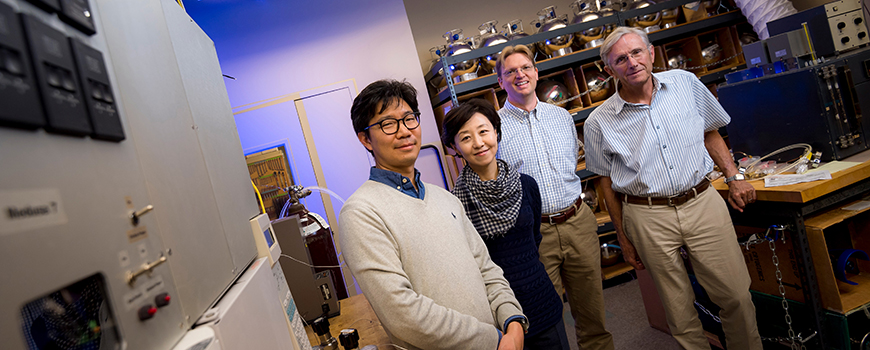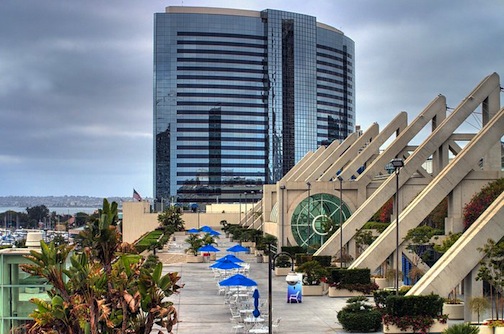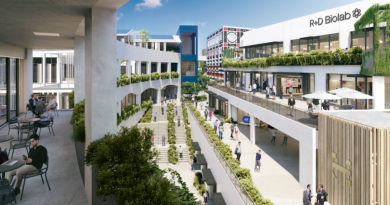Daily Business Report-May 28, 2019
Lead author Sunyoung Park (second from left) and Scripps co-authors (l-r) Jooil Kim, Jens Mühle, Ray Weiss. (Photo: Erik Jepsen)
Scientists discover source
of new CFC emissions
Since 2013, annual emissions of a banned chlorofluorocarbon (CFC) have increased by around 7,000 tons from eastern China, according to new research by an international team of scientists that includes researchers from Scripps Institution of Oceanography at the University of California San Diego.
The study, “Increase in CFC-11 emissions from eastern China based on atmospheric observations,” will be published May 23 in the journal Nature.
Last year, it was reported that emissions of one of the most important ozone depleting substances, CFC-11, had increased. This surprise finding indicated to researchers and policy makers around the world that someone somewhere was likely producing thousands of tons of CFC-11, despite a global phase-out since 2010 under the Montreal Protocol.
“Through global monitoring networks such as the Advanced Global Atmospheric Gases Experiment (AGAGE) and the National Oceanic and Atmospheric Administration Global Monitoring Division (NOAA GMD), scientists have been making measurements of chlorofluorocarbons (CFCs) in the atmosphere for over 40 years,” said Matt Rigby, a lead author of the study and Reader in Atmospheric Chemistry at the University of Bristol in England. “In recent decades, we’ve primarily seen declining CFC emissions reflected in these measurements because of the Montreal Protocol. Therefore, it was unexpected when we saw that, starting around 2013, global emissions of one of the most important CFCs suddenly began to grow.”
This finding was concerning because CFCs are the main culprits in depletion of the stratospheric ozone layer, which protects us from the sun’s ultra-violet radiation. Any increase in emissions of CFCs will delay the time it takes for the ozone layer, and the Antarctic ozone “hole,” to recover.
But where were these new emissions coming from? Until now, researchers only had an indication that at least part of the source was located somewhere in eastern Asia.
____________________
Pamela Garzone named chief
medical officer of Calibr

Pamela Garzone, an industry leader in translational research and clinical development, has been appointed chief medical officer of Calibr, the drug development arm of Scripps Research. This appointment fills a critical leadership role as several of Calibr’s portfolio programs advance toward the clinic. Garzone most recently served as vice president within the early oncology development clinical research group at Pfizer, where she held a leadership role for a wide range of cancer-focused drug development programs. She also brings decades of earlier experience spanning biotech, pharma, and academia. Calibr is currently developing multiple drug candidates, including KA34, a potential osteoarthritis therapy that was discovered by Scripps Research scientists and is currently being evaluated in a phase 1 human clinical trial. Later this year, Calibr plans to submit investigational new drug (IND) applications to the FDA for two novel cancer therapies: a bispecific antibody for prostate cancer and a “switchable” CAR-T therapy that could potentially be a universal approach for treating many different tumor types. Within two to three years, up to five more programs rooted in discoveries made at Calibr and Scripps Research are expected to advance to clinical trials.
____________________
Health Occupations Center celebrates groundbreaking
for new vocational classroom and medical lab buildings
An informal groundbreaking ceremony will be held May 29 to mark construction of two new vocational classroom and medical lab buildings for the Health Occupations Center(HOC) in Santee, one of four Adult Educationprogram sites for the Grossmont Union High School District (GUHSD). The new buildings will include two phlebotomy labs, as well as pharmacy and dental labs, and new medical lab and classroom areas for the Vocational Nurse, Certified Nursing Assistant, Medical Assistant, and Emergency Medical Technician programs. The Health Occupations Center project is the latest modernization project for GUHSD, funded by Proposition U and Measure BB. The new buildings will include spacious medical labs and classrooms outfitted with state-of-the-art healthcare technology, equipment, and simulation spaces, and will enable the District’s Adult Education program to enroll more students in these in-demand workforce industries. The Bureau of Labor Statistics reports healthcare occupationsare projected to grow 18 percent from now until 2026, must faster than the average for all other occupations, adding about 2.4 million new jobs. The $5.2 million Health Occupations Center project will include a number of ‘green’ features, including: high efficiency plumbing and fixtures; locally sourced, durable and low volatile organic compounds; materials; maximized use of natural daylighting.
____________________
SDSU announces partnership with JMI Sports
and Legends for proposed Mission Valley stadium
On behalf of SDSU and in collaboration with SDSU Athletics, JMI Sports and Legends will manage the stadium project as part of the proposed campus expansion at SDSU Mission Valley.
“This is an exciting collaboration, and this joint venture will greatly enhance our capacity to create the types of experiences our students, faculty, staff, regional community and visitors have yet to see,” said SDSU President Adela de la Torre.
“With the proposed stadium, campus and other features, the new neighborhood environment we plan to build will create the types of social, intellectual and economic benefits that will invigorate our entire region,” de la Torre said. “I am proud of our team. I am also grateful for the vision we have defined and will now carry forward with our partners in JMI Sports and Legends.”
JMI Sports and Legends will plan, strategize and execute ticketing, premium sales, naming rights and founding partnerships for the proposed stadium. As proposed, the 35,000 capacity multi-use stadium will serve primarily as the home of SDSU football and will also accommodate professional and collegiate soccer matches, concerts and other events, and can play host to a number of academic and integrated experiences.
To design and build the proposed new stadium, SDSU recently hired Clark Construction and Gensler. As proposed, the new stadium will hold a major footprint at SDSU Mission Valley, a comprehensive campus expansion project proposed to include a world-class university research and innovation district, housing, mixed use retail, and more than 80 acres of public open space and a river park.



